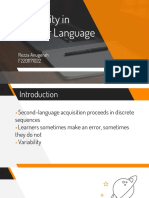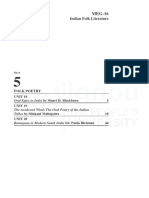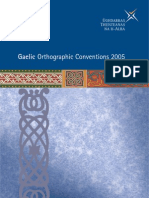The Influence of Sanskrit in Odia Language Abstract
The Influence of Sanskrit in Odia Language Abstract
Uploaded by
DibakamiKrutarthaCopyright:
Available Formats
The Influence of Sanskrit in Odia Language Abstract
The Influence of Sanskrit in Odia Language Abstract
Uploaded by
DibakamiKrutarthaCopyright
Available Formats
Share this document
Did you find this document useful?
Is this content inappropriate?
Copyright:
Available Formats
The Influence of Sanskrit in Odia Language Abstract
The Influence of Sanskrit in Odia Language Abstract
Uploaded by
DibakamiKrutarthaCopyright:
Available Formats
The influence of Sanskrit Literature in Odia Language
With
Special Reference to Chaa mna-thaguntha
Dibakami Krutartha
Ph. D Scholar
Dept of Indology
French Institute of Pondicherry
The language is the human capacity for receiving and using complex systems of communication
and also it is a system of symbols. It is one of the several forms of human communication. There are 6000-
7000 languages in the world and in modern India today has 415 living languages from which 196 are
endangered and 9 are extinct languages, while the 18 languages are recognized by the constitution have
large speech communities. There are two major language families in India one is indo-Aryan language
spoken by approximately 73% of Indians (North) and other one is Dravidian spoken by 24% Indians
(South) and rest of are some few minor and tribal languages. Sanskrit is known as the oldest language in
human history especially in India and also the mother of all modern Indian languages. The development of
modern Indian languages is traced as: Sanskrit-Prakrit-Apabhransh-modern languages for both Dravidian
and Indo-Aryan language families. This is more applicable in north Indian then south.
Sanskrit is an ancient, oldest and also a classical language of India. Sanskrit is the root and
inspiration for virtually every language spoken in India. It has large and extremely rich body of ancient
literature and also one of the earliest members of the Indo-European language family. It has a same position
in India as Latin and Greek in Europe. The word samskrata in the strictest sense, means purified, sacred,
and holy. Sanskrit usually referred to as Samskrata Vak which means a refined language. It is always
considered as a religious language and also a language of Gods (Devabhasa) in which every ancient Hindu
text, mostly devotional text, has been written in. Sanskrit also has been the language of shastra, of
knowledge of the Indian tradition. There are so many texts are available in Sanskrit on politics, philosophy,
mathematics, astrology, theology and also in medicine. Sanskrit is mother of all Indian languages, so Odia
language is one of them.
Odia is the regional and official language of Odisha which is situated in the Eastern part of India.
And second official language of Jharkhand. It is also an Eastern Indo-Aryan language. It is the first Indo-
Aryan classical language of India. It is thought to be direct descendent from Magadhi Prakrit similar to
Ardha Magadhi and also had relatively little influence from Persian and Arabic, compared to other major
north Indian languages. Odia language is not only spoken by Odisha but also in some neighboring state like
West Bengal, Jharkhand, Andhra Pradesh and also in Gujraat.
The history of Odia literature begins in the 14
th
century A.D with the poet Sarala dass work
Vilanka Ramayana and Chandi Purana thats why he is known as Adi kavi in Odia. There are so many
Odia scholars and their contribution to Odia language is never-to-be-forgotten. They are Jagannath Das,
Upendra Bhanja, Bhima Bhoi, Radhanath ray and Fakir Mohan Senapati etc. Fakir Mohan Senapati (1843-
1918) is one of them. He is a multitalented genius who changed the method of Odia language and started
modernism in Odia. Thats why he is known as the Father of Modern Odia Literature and also
remembered as Vyasa kabi. He wrote a novel, so many short stories, poems, essays and some school text
books as well as translated a number of Sanskrit texts into Odia. Some famous books written by Fakir
Mohan Senapati are Mamu, Lachama, and a novel Chaa mna-thaguntha and his book Atma jivana
charita (The story of my life) is the first autobiography in Odia language. Chaa mna-thaguntha (Six
acres and a third) is a 19
th
century novel which is not only famous in India but also in western countries. It
tells a story of an evil landlord, Ramachandra Mangaraj, who exploits poor farmers and use the new legal
systems to take the property of others. It is also based on ancient culture, the social and political issue of
Odisha. In other word we can see that describe about ordinary people and also it contains a critique of
British colonial roles.
Fakir Mohan Senapati used so many words that are directly and indirectly related to the Sanskrit
and also some verses in his novel. This present paper will discuss about how Sanskrit Literature is
influenced in Odia language especially in the novel Chaa mna-thaguntha (Six acres and a third).
You might also like
- Nelson Grammar Teachers Book Look InsideDocument1 pageNelson Grammar Teachers Book Look InsidePedro Osorio G.33% (3)
- Complete Causelist 12th January 2023Document356 pagesComplete Causelist 12th January 2023MaheshNo ratings yet
- GRADE 5 TERM 2 ENGLISH SCHEMES (Skills)Document16 pagesGRADE 5 TERM 2 ENGLISH SCHEMES (Skills)abuka.felix80% (5)
- K.Ramasamy Iyer'S (Ramakullam Estate) Family Welfare ForumDocument4 pagesK.Ramasamy Iyer'S (Ramakullam Estate) Family Welfare ForumkckejamanNo ratings yet
- Shunglu ReportDocument235 pagesShunglu ReportNDTVNo ratings yet
- SLA - PPT Variability in Language LearnerDocument14 pagesSLA - PPT Variability in Language LearnerRezza Anugerah100% (1)
- Past Simple 2 Interrogative, Negative, Mixed FormsDocument28 pagesPast Simple 2 Interrogative, Negative, Mixed FormskaltrinaNo ratings yet
- Pañcatantra of DurgasimhaDocument65 pagesPañcatantra of DurgasimhaNajaf Haider100% (1)
- NewspapersDocument562 pagesNewspapersVivek_U0% (1)
- New BookSuppliers13Document8 pagesNew BookSuppliers13Ankit YadavNo ratings yet
- Book of Abstracts InPAC2023Document255 pagesBook of Abstracts InPAC2023Dinesh KiranNo ratings yet
- (Zone14NagarNigamइंदौरward62)Document172 pages(Zone14NagarNigamइंदौरward62)Manish JaiswalNo ratings yet
- C-489, Dda Lig Flats, East of Loni Road, DELHI - 110093Document3 pagesC-489, Dda Lig Flats, East of Loni Road, DELHI - 110093karmaNo ratings yet
- Sarva Shiksha Abhiyan Chhattisgarh: AWP & B - 2005 - 06 (State Component)Document277 pagesSarva Shiksha Abhiyan Chhattisgarh: AWP & B - 2005 - 06 (State Component)Somesh ChauhanNo ratings yet
- Uttarakhand Public Service Commission Ukpsc GK State Pcs EnglishDocument8 pagesUttarakhand Public Service Commission Ukpsc GK State Pcs EnglishneeteshprabhakarNo ratings yet
- Mahaseva Co In1606994974Document40 pagesMahaseva Co In1606994974MahasevaNo ratings yet
- Jain BAzar Chowk Chabutra Upper BAzarDocument4 pagesJain BAzar Chowk Chabutra Upper BAzarMANSA MARKETINGNo ratings yet
- Trikuta NagarDocument18 pagesTrikuta NagarMANSA MARKETINGNo ratings yet
- Life MembersDocument26 pagesLife MembersMahadev MuleNo ratings yet
- Rajiv Gandhi Foundation 2007-08 CHK DonorsDocument4 pagesRajiv Gandhi Foundation 2007-08 CHK DonorsSaumya RiteshNo ratings yet
- List of Black BeltDocument34 pagesList of Black BeltHarsh Deep100% (1)
- Indian Community Group in AustraliaDocument19 pagesIndian Community Group in AustraliaAkhil SanadhyaNo ratings yet
- List of Small Hydro Power Projects Up To 5 MW HimurjaDocument440 pagesList of Small Hydro Power Projects Up To 5 MW Himurjaasdf.yoyo19No ratings yet
- A878AUGDocument27 pagesA878AUGshravan AnvekarNo ratings yet
- PTTP UttarakhandDocument25 pagesPTTP UttarakhandGaurav SinghalNo ratings yet
- SodapdfDocument993 pagesSodapdfjaya duklanNo ratings yet
- Chapter - V - 14th September - 2021 - Business Activities of Jains From Ancient To Medieval PeriodDocument19 pagesChapter - V - 14th September - 2021 - Business Activities of Jains From Ancient To Medieval PeriodRohan MehtaNo ratings yet
- Burrard 1914 - Records of Survey of India, Vol. 4: Explorations On The NE Frontier 1911-13Document100 pagesBurrard 1914 - Records of Survey of India, Vol. 4: Explorations On The NE Frontier 1911-13NathanStraubNo ratings yet
- National Register of Large Dams 2015Document207 pagesNational Register of Large Dams 2015Thapa S100% (1)
- Compendium of VOs NGOs in GNCTDDocument350 pagesCompendium of VOs NGOs in GNCTDVishal DawarNo ratings yet
- People Groups of IndiaDocument36 pagesPeople Groups of Indiaapi-3711938No ratings yet
- Branch List Offering Doorstep Banking12012020Document36 pagesBranch List Offering Doorstep Banking12012020Avijit ParidaNo ratings yet
- Haryana Vaccine CentreDocument19 pagesHaryana Vaccine CentreSaad Bin OmerNo ratings yet
- Panel of ArbitratorsDocument29 pagesPanel of ArbitratorsAbhay KapkotiNo ratings yet
- Price List NISCAIR PublicationsDocument16 pagesPrice List NISCAIR PublicationsSajal SahaNo ratings yet
- Iti Trade Wise ListDocument85 pagesIti Trade Wise Listuma sakhareNo ratings yet
- Pincode. CB455706604Document3,264 pagesPincode. CB455706604Gabru Singh0% (1)
- IAS Transfer ListDocument5 pagesIAS Transfer Listdilliwar.deepakNo ratings yet
- List of Zonal OfficesDocument4 pagesList of Zonal OfficesAnonymous 2sMrM8cNo ratings yet
- People of IndiaDocument57 pagesPeople of IndiaMaithri KamalakarNo ratings yet
- Indore Startup ClientsDocument3 pagesIndore Startup Clientsssuryakartik2No ratings yet
- List of Banks in TELANGANA With IFSC Codes PDFDocument2 pagesList of Banks in TELANGANA With IFSC Codes PDFSatyanarayana Moorthy PiratlaNo ratings yet
- Google Reader PDFDocument215 pagesGoogle Reader PDFVineet KumarNo ratings yet
- ExecutivesDocument39 pagesExecutivesdharmender singhNo ratings yet
- Address of CSCs in Maharashtra PDFDocument774 pagesAddress of CSCs in Maharashtra PDFHarish100% (2)
- Member DirectoryDocument1 pageMember DirectoryDilip KumarNo ratings yet
- Read About O P Jindal Group Read About Shri O. P. Jindal: Sajjan Jindal (Vice Chairman & Managing Director)Document4 pagesRead About O P Jindal Group Read About Shri O. P. Jindal: Sajjan Jindal (Vice Chairman & Managing Director)Satwant SinghNo ratings yet
- Apollo Store ListDocument158 pagesApollo Store ListFinmark Business groupNo ratings yet
- Haridwar - RishikeshDocument4 pagesHaridwar - RishikeshTamal Kishore AcharyaNo ratings yet
- A Haven of Privacy, Luxury and Nature: 222 RajpurDocument35 pagesA Haven of Privacy, Luxury and Nature: 222 RajpurarkaranNo ratings yet
- St. Paul'S Higher Secondary School: Class Ix Entrance Examination 2023Document20 pagesSt. Paul'S Higher Secondary School: Class Ix Entrance Examination 2023Azaria LaltinkimaNo ratings yet
- The Examiner. Vol-66. No-34. 20 - 26 Aug 22Document36 pagesThe Examiner. Vol-66. No-34. 20 - 26 Aug 22swell2No ratings yet
- Guidance Document Bakery Sector 24-10-2017Document11 pagesGuidance Document Bakery Sector 24-10-2017melancholicNo ratings yet
- Beerayya Katha1Document31 pagesBeerayya Katha1jadigeetaNo ratings yet
- Unclaimed 3Document2,749 pagesUnclaimed 3tpartapNo ratings yet
- Vijayanagar & Bahami KingdomDocument22 pagesVijayanagar & Bahami Kingdomneha0% (1)
- The Influence of Sanskrit Literature in Odia Language FinalDocument6 pagesThe Influence of Sanskrit Literature in Odia Language FinalDibakamiKrutartha100% (1)
- Prakrit and PaliDocument2 pagesPrakrit and PalixyzabcdjgeuigfuegNo ratings yet
- Towards The Concept of A New Nationhood: Languages and Literatures in IndiaDocument13 pagesTowards The Concept of A New Nationhood: Languages and Literatures in IndiaALAKA RAJEEV 1930317No ratings yet
- U R AnanthamurthyDocument7 pagesU R AnanthamurthyMEENAKSHINo ratings yet
- Linguistics History of IndiaDocument28 pagesLinguistics History of IndiaChandranshu Garg100% (1)
- Block-5 Folk PoetryDocument54 pagesBlock-5 Folk Poetryyashica tomarNo ratings yet
- What Are The Ancient Indian Languages LeverageDocument1 pageWhat Are The Ancient Indian Languages Leveragediljale9005No ratings yet
- InglesDocument2 pagesInglesEricka HerreraNo ratings yet
- Practising Cae Speaking Part 1Document10 pagesPractising Cae Speaking Part 1Lore BobocNo ratings yet
- Mentor Text SetDocument14 pagesMentor Text Setapi-282245829No ratings yet
- Week 5 Class 1: Student Worksheet Main CourseDocument9 pagesWeek 5 Class 1: Student Worksheet Main CourseJavi PulgarinNo ratings yet
- Bab I: - University of PGRI Adi Buana SurabayaDocument10 pagesBab I: - University of PGRI Adi Buana Surabayamei indahNo ratings yet
- 6 Tips For PT3 English ListeningDocument3 pages6 Tips For PT3 English ListeningdeasaadiahNo ratings yet
- The Sound of English Free Sample by Pronunciation StudioDocument18 pagesThe Sound of English Free Sample by Pronunciation StudioMahmoud SherifeNo ratings yet
- Counter Argument Thesis StatementDocument8 pagesCounter Argument Thesis Statementafjrfisbt100% (1)
- Bing 1Document62 pagesBing 1Vania VasthiiNo ratings yet
- SLA AssignmentDocument11 pagesSLA AssignmentMary Bortagaray67% (9)
- Which TenseDocument3 pagesWhich TenseHenry VargasNo ratings yet
- Australia and New Zealand EnglishDocument29 pagesAustralia and New Zealand EnglishJovana AksentijevićNo ratings yet
- Unit 2 Sentences, Clauses, and PhrasesDocument16 pagesUnit 2 Sentences, Clauses, and PhrasesNezukoNo ratings yet
- Tema 6 - Natural EnvironmentDocument24 pagesTema 6 - Natural EnvironmentALfredo ROldanNo ratings yet
- Noun ClauseDocument13 pagesNoun ClauseBagas MartinusNo ratings yet
- Workplace Communication Skills U2Document97 pagesWorkplace Communication Skills U2Foo Chuat MengNo ratings yet
- SEA Lesson 2 - RubricDocument1 pageSEA Lesson 2 - RubricMME FTENo ratings yet
- Grammar 1: Adjectives, Negative Prefixes and ComparisonsDocument2 pagesGrammar 1: Adjectives, Negative Prefixes and Comparisonso_claudia19No ratings yet
- Beehive - Tests - Level 2 - Unit Test 7Document4 pagesBeehive - Tests - Level 2 - Unit Test 7Adrian Andres Gallo Lopez100% (1)
- Gaelic Orthographic Conventions 2005Document42 pagesGaelic Orthographic Conventions 2005gael1967No ratings yet
- Grammar - Vocabulary - 1star - Unit9 2013 03 20 18 42 08 PDFDocument1 pageGrammar - Vocabulary - 1star - Unit9 2013 03 20 18 42 08 PDFIsalor3No ratings yet
- Dance Critique PaperDocument3 pagesDance Critique Paperapi-243405519No ratings yet
- English 8 Curriculum GuideDocument60 pagesEnglish 8 Curriculum GuideSolarEclipp CandelansaNo ratings yet
- DirectionsDocument46 pagesDirectionsmba departmentNo ratings yet
- Class 1newDocument4 pagesClass 1newARTES APOLONo ratings yet
- 2013sepa Hearing Dogs KeyDocument3 pages2013sepa Hearing Dogs KeySarah VazquezNo ratings yet

























































































